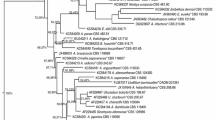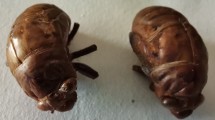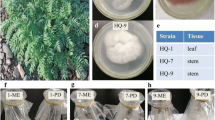Abstract
Bacterial strains (93 isolates) capable of growth on full-strength nutrient media were isolated from 86 fungal fruit bodies collected in the Moscow region. Antimicrobial activity of the endobiont isolates against 12 bacterial and fungal test strains (including drug-resistant ones) was studied in submerged cultures. Most of the strains (84.9%) were found to produce antibiotic compounds with different antimicrobial properties, including antifungal activity in 18.3% of the strains. Morphological characteristics and analysis of the 16S rRNA gene sequences were used to determine the taxonomic position of 16 bacterial strains of the following 10 species: Bacillus subtilis, Ewingella americana, Pseudomonas sp., Stenotrophomonas maltophilia, as well as Achromobacter spanius, B. licheniformis, Hafnia paralvei, Micrococcus terreus, Nocardia coeliaca, and St. rhizophila, which have not been previously known to be endobionts of basidiomycete fruit bodies. Antimicrobial activity of A. spanius, E. americana, H. paralvei, M. terreus, N. coeliaca, and St. rhizophila has not been reported previously. Complex mechanisms of symbiotic relations between fungi and bacteria, including those associated with antibiotic formation, probably developed in the course of co-evolution.
Similar content being viewed by others
References
Abbott, S.L., Moler, S., Green, N., Tran, R.K., Wainwright, K., and Janda, J.M., Clinical and laboratory diagnostic characteristics and cytotoxigenic potential of Hafnia alvei and Hafnia paralvei strains, J. Clin. Microbiol., 2011, vol. 49, no. 9, pp. 3122–3126.
Agnolucci, M., Battini, F., Cristani, C., and Giovannetti, M., Diverse bacterial communities are recruited on spores of different arbuscular mycorrhizal fungal isolates, Biol. Fertil. Soils., 2015, vol. 51, no. 3, pp. 379–389.
Bérdy, J., Bioactive microbial metabolites, J. Antibiot., 2005, vol. 58, pp. 1–26.
Biskupiak, J.E., Meyers, E., Gillum, A.M., Dean, L., Trejo, W.H., and Kirsch, D.R., Neoberninamycin, a new antibiotic produced by Micrococcus luteus, J. Antibiot., 1988, vol. 41, no. 5, pp. 684–687.
Chin, Y.-W., Balunas, M.J., Chai, H.B., and Kinghorn, A.D., Drug discovery from natural sources, AAPS J., 2006, vol. 8, no. 2, pp. 239–253.
Dahm, H., Wrótniak, W., Strzelczyk, E., Li, C.-Y., and Bednarska, E., Diversity of culturable bacteria associated with fruiting bodies of ectomycorrhizal fungi, Phytopathol. Pol., 2005, vol. 38, pp. 51–62.
de Carvalho, M.P., Türck, P., and Abraham, W.-R., Secondary metabolites control the associated bacterial communities of saprophytic basidiomycotina fungi, Microbes Environ., 2015, vol. 30, pp. 196–198.
Emmart, E.W., A new tuberculostatic antibiotic from a species of Nocardia, Am. Rev. Tuberc. Pulm. Dis., 1947, vol. 56, pp. 316–318.
Fickers, P., Antibiotic compounds from Bacillus: why are they so amazing?, Am. J. Biochem. Biotechnol., 2012, vol. 8, no. 1, pp. 40–46.
Gordon, R.E., Barnett, D.A., Handerhan, J.E., and Pang, C.H.-N., Nocardia coeliaca, Nocardia autotrophica, and the Nocardin strain, Int. J. Syst. Bacteriol., 1974, vol. 24, no. 1, pp. 54–63.
Inglis, P.W., Burden, J.L., and Peberdy, J.F., Evidence for the association of the enteric bacterium Ewingella americana with internal stipe necrosis of Agaricus bisporus, Microbiology (UK), 1996, vol. 142, pp. 3253–3260.
Jakobi, M.I., Winkelmann, G., Kaiser, D., Kempler, C., Jung, G., Berg, G., and Bahl, H., Maltophilin: a new antifungal compound produced by Stenotrophomonas maltophilia R3089, J. Antibiot. (Tokyo), 1996, vol. 49, no. 11, pp. 1101–1104.
Kobayashi, D.Y. and Crouch, J.A., Bacterial/fungal interactions: from pathogens to mutualistic endosymbionts, Annu. Rev. Phytopathol., 2009, vol. 47, pp. 63–82.
Kumari, D., Reddy, M.S., and Upadhyay, R.C., Diversity of cultivable bacteria associated with fruiting bodies of wild Himalayan Cantharellus spp., Ann. Microbiol., 2012, vol. 63, pp. 845–853.
Leveau, J.H. and Preston, G.M., Bacterial mycophagy: definition and diagnosis of a unique bacterial-fungal interaction, New Phytol., 2007, vol. 177, pp. 859–876.
Loeb L.J., Moyer A., Murray R.J.E., An antibiotic produced by Micrococcus epidermidis, Can. J. Res., 1950, vol. 28, no. 5, pp. 212–216.
Malanicheva, I.A., Kozlov, D.G., Efimenko, T.A., Zenkova, V.A., Katrukha, G.S., Reznikova, M.I., Korolev, A.M., Borshchevskaya, L.N., Tarasova, O.D., Sineokii, S.P., and Efremenkova, O.V., New Antibiotics Produced by Bacillus subtilis Strains, Microbiology (Moscow), 2014, vol. 83, no. 4, pp. 352–356.
PCR Protocols: A Guide to Methods and Applications, Innis, M.A., Gelfand, D.H., Sninsky, J.J., and White, T.J., Eds., New York: Academic, 1990.
Raaijmakers, J.M., De Bruijn, I., Nybroe, O., and Ongena, M., Natural functions of lipopeptides from Bacillus and Pseudomonas: more than surfactants and antibiotics, FEMS Microbiol. Rev., 2010, vol. 34, no. 6, pp. 1037–1062.
Reyes, J.E., Venturini, M.E., Oria, R., and Blanco, D., Prevalence of Ewingella americana in retail fresh cultivated mushrooms (Agaricus bisporus, Lentinula edodes and Pleurotus ostreatus) in Zaragoza (Spain), FEMS Microbiol. Ecol., 2004, vol. 47.? 3. P. 291–296.
Smirnov, V.V. and Kiprianova, E.A., Bakterii roda Pseudomonas (Bacteria of the Genus Pseudomonas), Aizenman, B.E., Ed., Kiev: Naukova Dumka, 1990.
Soler-Rivas, C., Jolivet, S., Arpin, N., Olivier, J.M., and Wichers, H.J., Biochemical and physiological aspects of brown blotch disease of Agaricus bisporus, FEMS Microbiol. Rev., 1999, vol. 23, pp. 591–614.
Warmink, J.A., Nazir, R., and van Elsas, J.D., Universal and species-specific bacterial ‘fungiphiles’ in the mycospheres of different basidiomycetous fungi, Environ. Microbiol., 2009, vol. 11, pp. 300–312.
Wolf, A., Fritze, A., Hagemann, M., and Berg, G., Stenotrophomonas rhizophila sp. nov., a novel plant-associated bacterium with antifungal properties, Int. J. Syst. Evol. Microbiol., 2002, vol. 52, pp. 1937–1944.
Zagryadskaya, Yu.A., Lysak, L.V., Sidorova, I.I., Aleksandrova, A.V., and Voronina, E.Yu., Bacterial complexes of the fruiting bodies and hyphosphere of certain basidiomycetes, Biol. Bull., 2013, no. 4, pp. 358–364.
Zagryadskaya, Yu.A., Lysak, L.V., Sidorova, I.I., and Aleksandrova, A.V., Bacterial communities of the loci formed by basidiomycetes in a forest biocenosis, Sovremennaya mikologiya v Rossii (Modern Mycology in Russia), Proc. 3rd Internatl. Mycol. Forum, D’yakov, Yu.T. and Sergeev, Yu.V., Eds., Moscow: Natl. Acad. Mycol., 2015, Ser. 6, vol. 5, pp. 407–409.
Zagryadskaya, Yu.A., Lysak, L.V., Voronina, E.Yu., Aleksandrova, A.V., and Sidorova, I.I., Characterization of bacterial communities of basidiomycete fruit bodies and hyphosphere, Sovremennaya mikologiya v Rossii (Modern Mycology in Russia), Proc. 3rd Congr. Mycol. Russia, Moscow: Natl. Acad. Mycol., 2012, vol. 3, p. 180.
Zhang, J.-Y., Liu, X.-Y., and Liu, S.-J., Agrococcus terreus sp. nov. and Micrococcus terreus sp. nov., isolated from forest soil, Int. J. Syst. Evol. Microbiol., 2010, vol. 60, pp. 1897–1903.
Author information
Authors and Affiliations
Corresponding author
Additional information
Original Russian Text © T.A. Efimenko, I.A. Malanicheva, B.F. Vasil’eva, A.A. Glukhova, I.G. Sumarukova, Yu.V. Boikova, N.D. Malkina, L.P. Terekhova, O.V. Efremenkova, 2016, published in Mikrobiologiya, 2016, Vol. 85, No. 6, pp. 740–747.
Rights and permissions
About this article
Cite this article
Efimenko, T.A., Malanicheva, I.A., Vasil’eva, B.F. et al. Antibiotic activity of bacterial endobionts of basidiomycete fruit bodies. Microbiology 85, 752–758 (2016). https://doi.org/10.1134/S0026261716060084
Received:
Published:
Issue Date:
DOI: https://doi.org/10.1134/S0026261716060084




